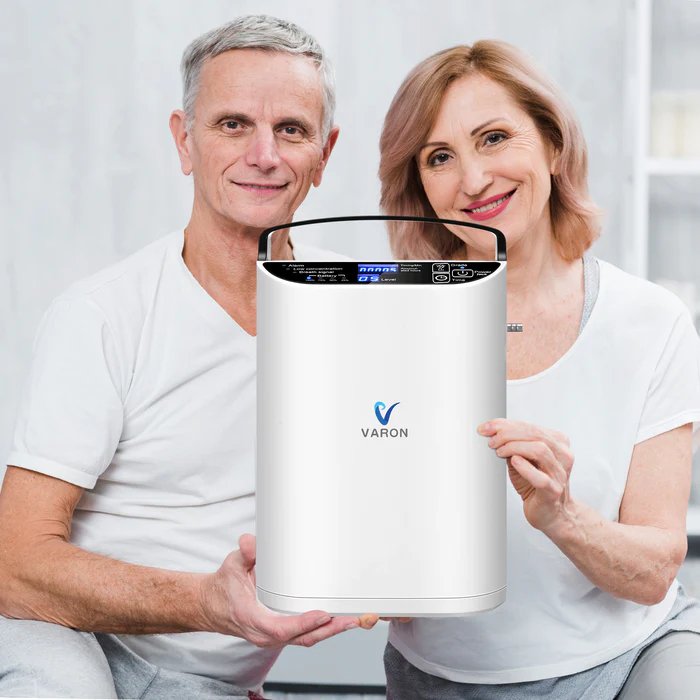Holiday Sale
Up to 20% off
Get your portable oxygen machine at record-breaking prices.

How to Use an Oxygen Concentrator Without Power
An oxygen concentrator is a vital device for individuals who require supplemental oxygen to manage their respiratory conditions. However, How to use an oxygen concentrator without a power supply it can be a cause for concern when the power goes out, especially if you rely on the concentrator for your oxygen needs. Fortunately, there are several options available to ensure you can continue using your oxygen concentrator even without power.
1. Battery Backup
One of the most common solutions for using an oxygen concentrator during a power outage is to have a battery backup system. Many concentrators come with built-in batteries that can provide several hours of operation. It is essential to ensure that your concentrator has a battery backup feature when purchasing one.
Additionally, you may consider investing in an external battery pack or a portable power station. These devices can provide an extended power supply to your concentrator, allowing you to use it for a more extended period without access to electricity. Make sure to check the compatibility of the battery backup system with your specific oxygen concentrator model.
2. Portable Oxygen Concentrators
If you anticipate frequent power outages or need a more reliable solution, you may opt for a portable oxygen concentrator (POC). Unlike traditional concentrators, POCs are designed to be lightweight, compact, and operate on battery power.
Portable oxygen concentrators are equipped with rechargeable batteries that can last for several hours, depending on the model and settings. Some POCs also have the option to charge the batteries using a car adapter, giving you additional flexibility during power outages.
It is important to note that portable oxygen concentrators may have limitations in terms of flow rate and oxygen purity compared to their stationary counterparts. Consult with your healthcare provider to determine if a POC is suitable for your oxygen therapy needs.
3. Oxygen Cylinders
Another option to consider during a power outage is using oxygen cylinders. These are portable tanks filled with compressed oxygen that can provide a reliable source of oxygen when electricity is not available. Oxygen cylinders come in various sizes, allowing you to choose one that suits your specific requirements.
However, it is crucial to ensure that you have a sufficient supply of oxygen cylinders on hand and that they are regularly refilled or replaced as needed. Proper storage and handling of oxygen cylinders are also essential to maintain their safety and effectiveness.
What to Do if the Power Goes Out with an Oxygen Concentrator?
While it is essential to have a backup plan in place, unexpected power outages can still occur. If you find yourself in a situation where the power goes out and you are using an oxygen concentrator, here are some steps to take:
1. Stay Calm and Assess the Situation
Remain calm and assess the severity of the power outage. If it is a brief interruption, your concentrator’s internal battery may be sufficient to provide a temporary oxygen supply until the power is restored. If the outage is expected to be prolonged, you will need to implement your backup plan.
2. Activate Your Battery Backup
If your oxygen concentrator has a built-in battery backup or if you have an external battery pack, activate it immediately. This will ensure that you can continue receiving oxygen therapy without interruption. Follow the manufacturer’s instructions for charging and using the backup battery.
3. Contact Your Oxygen Supplier
If the power outage is prolonged and you are running low on oxygen supply, contact your oxygen supplier for assistance. They may be able to provide additional cylinders or arrange for an emergency oxygen delivery to your location.
Life Expectancy of an Oxygen Concentrator
“The expected service life of oxygen concentrators may vary depending on various factors such as brand, model, and maintenance. Taking VARON brand as an example, the average service life of its oxygen concentrators, when properly maintained and used normally, is usually between 2 and 4 years. However, the actual service life can also be influenced by other factors such as usage frequency and environmental conditions, so the specific expected service life may vary.”
Regular maintenance and proper care can significantly extend the life of your oxygen concentrator. Follow the manufacturer’s guidelines for cleaning and servicing your device. It is also essential to replace the filters as recommended to ensure optimal performance.
For more information on oxygen concentrators and their usage, consult with your healthcare provider or oxygen supplier. They can provide personalized guidance based on your specific needs and circumstances.
Centers for Disease Control and Prevention (CDC): Preparedness of Oxygen-dependent People for power outages
World Health Organization (WHO): Maintaining health care during power outages
Frequently Asked Questions (FAQs)
Answer: Although using a generator as a power source may be tempting, it is necessary to consult the manufacturer of the oxygen concentrator before doing so. Not all concentrators are compatible with generators, and using incompatible power sources may damage equipment or affect its performance. Always follow the manufacturer’s recommendations and guidelines.
Answer: If you need to evacuate or travel during a power outage, a portable oxygen concentrator (POC) is a convenient choice. The POC design is lightweight and powered by batteries, allowing you to continue receiving oxygen therapy on the go. Ensure that your POC is fully charged and that you have a backup battery or available power source.
